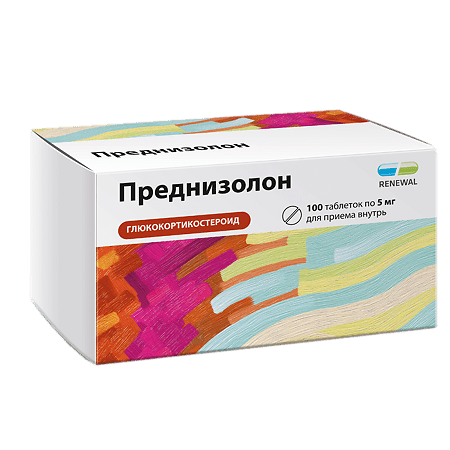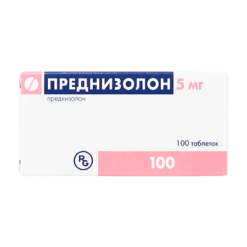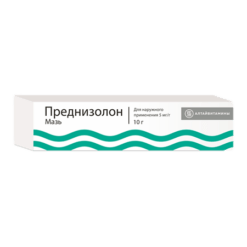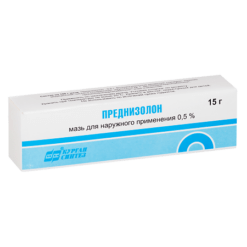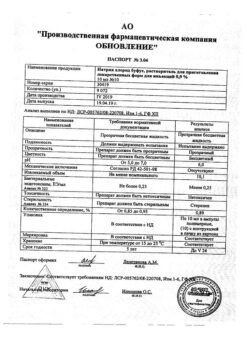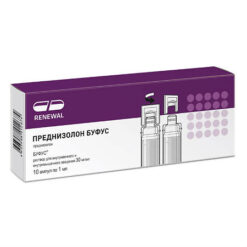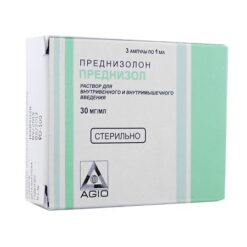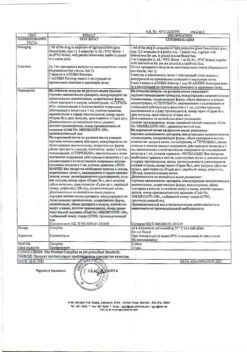No products in the cart.
Prednisolone, tablets 5 mg 100 pcs
€6.67 €5.38
Description
Pharmacotherapeutic group: glucocorticosteroid.
The ATX code: N02AB06
Pharmacological properties
Pharmacodynamics
Prednisolone is a synthetic glucocorticoid drug, a dehydrated analog of hydrocortisone. It has anti-inflammatory, anti-allergic, immunosuppressive effects, increases the sensitivity of beta-adrenoreceptors to endogenous catecholamines.
It interacts with specific cytoplasmic receptors (receptors for glucocorticosteroids are in all tissues, especially in liver) with the formation of complex, inducing the formation of proteins (including enzymes regulating vital processes in cells).
Protein metabolism: reduces the amount of globulin in the plasma, increases the synthesis of albumin in the liver and kidneys (with an increase of the albumin/globulin ratio), reduces synthesis and increases protein catabolism in muscle tissue.
Lipid metabolism: increases the synthesis of higher fatty acids and triglycerides, redistributes fat (fat accumulation occurs primarily in the shoulder girdle, face, abdomen), leads to hypercholesterolemia.
Carbohydrate metabolism: increases absorption of carbohydrates from the gastrointestinal tract; increases the activity of glucose-6-phosphatase (increased glucose flow from the liver into the blood); increases phosphoenolpyruvate carboxylase activity and aminotransferase synthesis (activation of gluconeogenesis); promotes hyperglycemia.
Water-electrolyte metabolism: retains sodium and water in the body, stimulates potassium excretion (mineralocorticoid activity), reduces the absorption of calcium from the gastrointestinal tract, reduces bone mineralization.
The anti-inflammatory effect is associated with inhibition of release of inflammatory mediators by eosinophils and mast cells, induction of formation of lipocortins and reduction of the number of mast cells producing hyaluronic acid, reduction of capillary permeability, stabilization of cell membranes (especially lysosomal) and organelle membranes. Acts on all stages of the inflammatory process: inhibits the synthesis of prostaglandins at the level of arachidonic acid (lipocortin inhibits phospholipase A2, inhibits arachidonic acid liberation and inhibits the biosynthesis of endoperoxides, leukotrienes that contribute to inflammation processes, allergies and others.), the synthesis of “pro-inflammatory cytokines” (interleukin 1, tumor necrosis factor alpha, etc.) and increases the resistance of the cell membrane to the action of various damaging factors.
The immunosuppressive effect is conditioned by involution of lymphoid tissue, suppression of lymphocyte proliferation (especially T-lymphocytes), suppression of B-cell migration and T- and B-lymphocyte interaction, inhibition of cytokine release (interleukin-1, 2 and gamma interferon) from lymphocytes and macrophages and reduction of antibody formation.
. Antiallergic effect results from decrease of synthesis and secretion of allergy mediators, inhibition of release of histamine and other bioactive substances from sensitized mast cells and basophils, decrease of number of circulating basophils, suppression of lymphoid and connective tissue development, decrease of T- and B-lymphocytes quantity, decrease of sensitivity of effector cells to allergy mediators, suppression of antibody formation, change of immune response of the body.
In obstructive respiratory tract diseases the action is mainly caused by inhibition of inflammatory processes, prevention or reduction of mucous membrane edema, decrease of eosinophilic infiltration of submucous layer of bronchial epithelium and deposition of circulating immune complexes in bronchial mucosa, and also inhibition of erosion and mucosa desquamation. It increases sensitivity of beta-adrenoreceptors of small and medium caliber bronchi to endogenous catecholamines and exogenous sympathomimetics, reduces mucus viscosity by reducing its production.
Suppresses the synthesis and secretion of adrenocorticotropic hormone and secondary to the synthesis of endogenous glucocorticosteroids.
Inhibits connective tissue reactions during the inflammatory process and reduces the possibility of scar tissue formation.
Pharmacokinetics
Prednisolone is well absorbed from the gastrointestinal tract when taken orally. Maximum concentration in blood is reached 1-1.5 h after oral administration. Up to 90% of the drug is bound to plasma proteins: transcortin (cortisol-binding globulin) and albumin. Prednisolone is metabolized in liver, partially in kidneys and other tissues, mainly by conjugation with glucuronic and sulfuric acids. Metabolites are inactive.
Extracted with bile and urine by glomerular filtration and 80-90% reabsorbed by tubules. 20% of the dose is excreted unchanged by the kidneys. The plasma elimination half-life after oral administration is 2-4 hours.
Indications
Indications
Systemic connective tissue diseases (systemic lupus erythematosus, scleroderma, periarteritis nodosa, dermatomyositis, rheumatoid arthritis);
acute and chronic inflammatory diseases of the joints: gouty and psoriatic arthritis, osteoarthritis (including post-traumatic), polyarthritis (including senile), glenohumeral periarthritis, ankylosing spondylitis (Bechterew’s disease), juvenile arthritis, Still’s syndrome in adults, bursitis, nonspecific tenosynovitis, synovitis and epicondylitis;
acute rheumatism, rheumatic carditis, minor chorea;
bronchial asthma, status asthmaticus;
acute and chronic allergic diseases, incl. allergic reactions to drugs and foods, serum sickness, urticaria, allergic rhinitis, Quincke’s edema, drug exanthema, hay fever, etc.;
skin diseases: pemphigus, psoriasis, eczema, atopic dermatitis (common neurodermatitis), contact dermatitis (affecting a large surface of the skin), toxicerma, seborrheic dermatitis, exfoliative dermatitis, toxic epidermal necrolysis (Lyell’s syndrome), bullous dermatitis herpetiformis, Stevens-Johnson syndrome;
cerebral edema (including due to a brain tumor or associated with surgery, radiation therapy or head injury) after prior parenteral use;
allergic eye diseases (allergic forms of conjunctivitis);
inflammatory eye diseases: sympathetic ophthalmia, severe sluggish anterior and posterior uveitis, optic neuritis;
primary or secondary adrenal insufficiency (including the condition after removal of the adrenal glands);
congenital adrenal hyperplasia;
kidney diseases of autoimmune origin (including acute glomerulonephritis);
nephrotic syndrome;
subacute thyroiditis;
diseases of the blood and hematopoietic system: agranulocytosis, panmyelopathy, autoimmune hemolytic anemia, lympho- and myeloid leukemia, lymphogranulomatosis, thrombocytopenic purpura, secondary thrombocytopenia in adults, erythroblastopenia (erythrocytic anemia), congenital (erythroid) hypoplastic anemia;
interstitial lung diseases: acute alveolitis, pulmonary fibrosis, sarcoidosis stages II-III;
tuberculous meningitis, pulmonary tuberculosis, aspiration pneumonia (in combination with specific chemotherapy);
berylliosis, Loeffler’s syndrome (not amenable to other therapy);
lung cancer (in combination with cytostatics);
multiple sclerosis;
gastrointestinal diseases: ulcerative colitis, Crohn’s disease, local enteritis;
hepatitis, hypoglycemic conditions;
prevention of graft rejection during organ transplantation;
hypercalcemia due to cancer, nausea and vomiting during cytostatic therapy;
multiple myeloma.
Pharmacological effect
Pharmacological effect
Pharmacotherapeutic group: glucocorticosteroid.
ATX code: N02AV06
Pharmacological properties
Pharmacodynamics
Prednisolone is a synthetic glucocorticoid drug, a dehydrated analogue of hydrocortisone. It has anti-inflammatory, antiallergic, immunosuppressive effects, increases the sensitivity of beta-adrenergic receptors to endogenous catecholamines.
Interacts with specific cytoplasmic receptors (receptors for glucocorticosteroids are found in all tissues, especially in the liver) to form a complex that induces the formation of proteins (including enzymes that regulate vital processes in cells).
Protein metabolism: reduces the amount of globulins in plasma, increases albumin synthesis in the liver and kidneys (with an increase in the albumin/globulin ratio), reduces synthesis and increases protein catabolism in muscle tissue.
Lipid metabolism: increases the synthesis of higher fatty acids and triglycerides, redistributes fat (fat accumulation occurs mainly in the shoulder girdle, face, abdomen), leads to the development of hypercholesterolemia.
Carbohydrate metabolism: increases the absorption of carbohydrates from the gastrointestinal tract; increases the activity of glucose-6-phosphatase (increasing the flow of glucose from the liver into the blood); increases the activity of phosphoenolpyruvate carboxylase and the synthesis of aminotransferases (activation of gluconeogenesis); promotes the development of hyperglycemia.
Water-electrolyte metabolism: retains sodium and water in the body, stimulates the excretion of potassium (mineralocorticoid activity), reduces calcium absorption from the gastrointestinal tract, reduces bone mineralization.
The anti-inflammatory effect is associated with inhibition of the release of inflammatory mediators by eosinophils and mast cells; inducing the formation of lipocortins and reducing the number of mast cells that produce hyaluronic acid; with a decrease in capillary permeability; stabilization of cell membranes (especially lysosomal) and organelle membranes. Acts on all stages of the inflammatory process: inhibits the synthesis of prostaglandins at the level of arachidonic acid (lipocortin inhibits phospholipase A2, suppresses the liberation of arachidonic acid and inhibits the biosynthesis of endoperoxides, leukotrienes, which contribute to the processes of inflammation, allergies, etc.), the synthesis of “proinflammatory cytokines” (interleukin 1, tumor necrosis factor alpha, etc.); increases the resistance of the cell membrane to the action of various damaging factors.
The immunosuppressive effect is caused by the involution of lymphoid tissue, inhibition of the proliferation of lymphocytes (especially T-lymphocytes), suppression of the migration of B cells and the interaction of T and B lymphocytes, inhibition of the release of cytokines (interleukin-1, 2; interferon gamma) from lymphocytes and macrophages and a decrease in the formation of antibodies.
The antiallergic effect develops as a result of a decrease in the synthesis and secretion of allergy mediators, inhibition of the release of histamine and other biologically active substances from sensitized mast cells and basophils, a decrease in the number of circulating basophils, suppression of the development of lymphoid and connective tissue, a decrease in the number of T- and B-lymphocytes, mast cells, a decrease in the sensitivity of effector cells to allergy mediators, inhibition of antibody formation, changes in the immune response body.
In obstructive diseases of the respiratory tract, the effect is due mainly to inhibition of inflammatory processes, prevention or reduction of the severity of swelling of the mucous membranes, reduction of eosinophilic infiltration of the submucosal layer of the bronchial epithelium and deposition of circulating immune complexes in the bronchial mucosa, as well as inhibition of erosion and desquamation of the mucosa. Increases the sensitivity of beta-adrenergic receptors of small and medium-sized bronchi to endogenous catecholamines and exogenous sympathomimetics, reduces the viscosity of mucus by reducing its production.
Suppresses the synthesis and secretion of adrenocorticotropic hormone and, secondarily, the synthesis of endogenous glucocorticosteroids.
Inhibits connective tissue reactions during the inflammatory process and reduces the possibility of scar tissue formation.
Pharmacokinetics
When taken orally, prednisolone is well absorbed from the gastrointestinal tract. The maximum concentration in the blood is achieved 1-1.5 hours after oral administration. Up to 90% of the drug binds to plasma proteins: transcortin (cortisol-binding globulin) and albumin. Prednisolone is metabolized in the liver, partially in the kidneys and other tissues, mainly by conjugation with glucuronic and sulfuric acids. Metabolites are inactive.
It is excreted in bile and urine by glomerular filtration and is 80-90% reabsorbed by the tubules. 20% of the dose is excreted unchanged by the kidneys. The plasma half-life after oral administration is 2-4 hours.
Special instructions
Special instructions
During treatment with the drug (especially long-term), observation by an ophthalmologist, monitoring of blood pressure, water and electrolyte balance, as well as peripheral blood patterns and blood glucose levels are necessary.
In order to reduce side effects, antacids can be prescribed, as well as increasing the intake of potassium in the body (diet, potassium supplements). Food should be rich in proteins, vitamins, and limit the content of fats, carbohydrates and table salt.
The effect of the drug is enhanced in patients with hypothyroidism and liver cirrhosis. The drug may worsen existing emotional instability or psychotic disorders. If a history of psychosis is indicated, the drug is prescribed in high doses under the strict supervision of a physician.
In stressful situations during maintenance treatment (for example, surgery, trauma or infectious diseases), the dose of the drug should be adjusted due to an increased need for glucocorticosteroids.
Patients should be carefully monitored for a year after the end of long-term therapy with the drug due to the possible development of relative insufficiency of the adrenal cortex in stressful situations.
With sudden withdrawal, especially in the case of previous use of high doses, the development of withdrawal syndrome (anorexia, nausea, lethargy, generalized musculoskeletal pain, general weakness) is possible, as well as an exacerbation of the disease for which the drug was prescribed.
During treatment with the drug, vaccination should not be carried out due to a decrease in its effectiveness (immune response).
When prescribing the drug for intercurrent infections, septic conditions and tuberculosis, it is necessary to simultaneously treat with bactericidal antibiotics.
In children, during long-term treatment with the drug, careful monitoring of the dynamics of growth and development is necessary. Children who during the treatment period were in contact with patients with measles or chickenpox are prescribed specific immunoglobulins prophylactically.
Due to the weak mineralocorticoid effect, the drug is used in combination with mineralocorticoids for replacement therapy for adrenal insufficiency.
In patients with diabetes mellitus, blood glucose levels should be monitored and therapy adjusted if necessary.
X-ray monitoring of the osteoarticular system (images of the spine, hand) is indicated.
In patients with latent infectious diseases of the kidneys and urinary tract, the drug can cause leukocyturia, which may have diagnostic value.
The drug increases the content of metabolites 11 and 17 of oxyketocorticosteroids.
The ability to influence the speed of reactions when driving vehicles or working with other mechanisms
No information available.
Active ingredient
Active ingredient
Prednisolone
Composition
Composition
Active substance:
prednisolone – 0.001 g – 0.005 g
Excipients:
sucrose – 0.0300 g – 0.1500 g
potato starch – 0.0185 g – 0.0925 g
stearic acid – 0.0005 g – 0.0025 g
Pregnancy
Pregnancy
During pregnancy (especially in the first trimester) it is used only for health reasons. With long-term therapy during pregnancy, fetal growth may be impaired. When used in the third trimester of pregnancy, there is a risk of atrophy of the adrenal cortex in the fetus, which may require replacement therapy in the newborn.
Since glucocorticosteroids pass into breast milk, if it is necessary to use the drug during breastfeeding, it is recommended to stop breastfeeding.
Contraindications
Contraindications
For short-term use for health reasons, the only contraindication is hypersensitivity to prednisolone or the components of the drug.
In children during the growth period, glucocorticosteroids should be used only for absolute indications and under the careful supervision of the attending physician.
With caution
Diseases of the gastrointestinal tract: peptic ulcer of the stomach and duodenum, esophagitis, gastritis, acute or latent peptic ulcer, recently created intestinal anastomosis, ulcerative colitis with the threat of perforation or abscess formation, diverticulitis.
Parasitic and infectious diseases of a viral, fungal or bacterial nature (current or recent, including recent contact with a patient): herpes simplex, herpes zoster (viremic phase), chicken pox, measles; amebiasis, strongyloidiasis; systemic mycosis; active and latent tuberculosis. Use for severe infectious diseases is permissible only against the background of specific therapy.
Pre- and post-vaccination period (8 weeks before and 2 weeks after vaccination), lymphadenitis after BCG vaccination.
Immunodeficiency conditions (including AIDS or HIV infection).
Diseases of the cardiovascular system, incl. recent myocardial infarction (in patients with acute and subacute myocardial infarction, the necrosis focus may spread, the formation of scar tissue may slow down and, as a result, the heart muscle will rupture), severe chronic heart failure, arterial hypertension, hyperlipidemia.
Endocrine diseases: diabetes mellitus (including impaired carbohydrate tolerance), thyrotoxicosis, hypothyroidism, Itsenko-Cushing’s disease, obesity (III-IV degrees).
Severe chronic renal and/or liver failure, nephrourolithiasis.
Hypoalbuminemia and conditions predisposing to its occurrence.
Systemic osteoporosis, myasthenia gravis, acute psychosis, poliomyelitis (except for the form of bulbar encephalitis), open- and closed-angle glaucoma, pregnancy.
Side Effects
Side Effects
The incidence and severity of side effects depends on the duration of use, the size of the dose used and the ability to comply with the circadian rhythm of drug administration.
When using the drug, the following side effects may occur.
From the endocrine system: decreased glucose tolerance, steroid diabetes mellitus or manifestation of latent diabetes mellitus, suppression of adrenal function, Itsenko-Cushing syndrome (moon-shaped face, pituitary-type obesity, hirsutism, increased blood pressure, dysmenorrhea, amenorrhea, muscle weakness, stretch marks), delayed sexual development in children.
From the digestive system: nausea, vomiting, pancreatitis, steroid ulcer of the stomach and duodenum, erosive esophagitis, gastrointestinal bleeding and perforation of the wall of the gastrointestinal tract, increased or decreased appetite, indigestion, flatulence, hiccups. In rare cases, increased activity of liver transaminases and alkaline phosphatase.
From the cardiovascular system: arrhythmias, bradycardia (up to cardiac arrest); development (in predisposed patients) or increased severity of heart failure, ECG changes characteristic of hypokalemia, increased blood pressure, hypercoagulation, thrombosis. In patients with acute and subacute myocardial infarction, the necrosis focus spreads, the formation of scar tissue slows down, which can lead to rupture of the heart muscle.
From the nervous system: delirium, disorientation, euphoria, hallucinations, manic-depressive psychosis, depression, paranoia, increased intracranial pressure, nervousness or anxiety, insomnia, dizziness, vertigo, pseudotumor of the cerebellum, headache, convulsions.
From the senses: posterior subcapsular cataract, increased intraocular pressure with possible damage to the optic nerve, a tendency to develop secondary bacterial, fungal or viral eye infections, trophic changes in the cornea, exophthalmos.
From the metabolic side: increased excretion of calcium, hypocalcemia, increased body weight, negative nitrogen balance (increased breakdown of proteins), increased sweating.
Caused by mineralocorticoid activity: fluid and sodium retention in the body (peripheral edema), hypernatremia, hypokalemic syndrome (hypokalemia, arrhythmia, myalgia or muscle spasm, unusual weakness and fatigue).
From the musculoskeletal system: slowing of growth and ossification processes in children (premature closure of the epiphyseal growth zones), osteoporosis (very rarely – pathological bone fractures, aseptic necrosis of the head of the humerus and femur), rupture of muscle tendons, steroid myopathy, decrease in muscle mass (atrophy).
From the skin and mucous membranes: delayed wound healing, petechiae, ecchymoses, thinning of the skin, hyper- or hypopigmentation, acne, stretch marks, tendency to develop pyoderma and candidiasis.
Allergic reactions: skin rash, itching, anaphylactic shock.
Other: development or exacerbation of infections (the appearance of this side effect is facilitated by jointly used immunosuppressants and vaccination), leukocyturia, withdrawal syndrome.
Interaction
Interaction
When prednisolone is prescribed simultaneously with:
– inducers of “liver” microsomal enzymes (phenobarbital, rifampicin, phenytoin, theophylline, ephedrine) – its concentration decreases;
– diuretics (especially “thiazide” and carbonic anhydrase inhibitors) and amphotericin B – increases the excretion of potassium from the body and increases the risk of developing heart failure;
– sodium-containing drugs – leads to the development of edema and increased blood pressure;
– cardiac glycosides – their tolerability worsens and the likelihood of developing ventricular extrasystoles increases (due to caused hypokalemia);
– muscle relaxants – hypokalemia caused by prednisolone can increase the severity and duration of muscle blockade;
– indirect anticoagulants – weakens (less often enhances) their effect (dose adjustment required);
– anticoagulants and thrombolytics – increases the risk of bleeding from ulcers in the gastrointestinal tract;
– ethanol and non-steroidal anti-inflammatory drugs (NSAIDs) – increases the risk of erosive and ulcerative lesions in the gastrointestinal tract and the development of bleeding (in combination with NSAIDs in the treatment of arthritis, it is possible to reduce the dose of glucocorticosteroids due to the summation of the therapeutic effect);
– paracetamol – the risk of developing hepatotoxicity increases (induction of liver enzymes and the formation of a toxic metabolite of paracetamol);
– acetylsalicylic acid – accelerates its elimination and reduces its concentration in the blood (when prednisolone is discontinued, the level of salicylates in the blood increases and the risk of side effects increases);
– insulin and oral hypoglycemic drugs, antihypertensive drugs – their effectiveness decreases;
– vitamin D – its effect on calcium absorption in the intestine is reduced;
– somatotropic hormone – the effectiveness of the latter decreases;
– praziquantel – the concentration of the latter decreases;
– M-anticholinergic blockers (including antihistamines and tricyclic antidepressants) and nitrates – helps increase intraocular pressure;
– isoniazid and mexelitine – increases their metabolism (especially in “slow” acetylators), which leads to a decrease in their plasma concentrations;
– carbonic anhydrase inhibitors and “loop” diuretics – increases the risk of developing osteoporosis;
– indomethacin – displaces prednisolone from its connection with albumin, increasing the risk of developing its side effects;
– adrenocorticotropic hormone – enhances the effect of prednisolone;
– ergocalciferol and parathyroid hormone – prevent the development of osteopathy caused by prednisolone;
– cyclosporine and ketoconazole – by slowing down the metabolism of prednisolone, they can, in some cases, increase its toxicity;
– androgens and anabolic steroid drugs – development of peripheral edema and hirsutism, the appearance of acne;
– estrogens and oral estrogen-containing contraceptives – the clearance of prednisolone decreases, which may be accompanied by an increase in the severity of its action;
– mitotane and other inhibitors of adrenal cortex function – may necessitate an increase in the dose of prednisolone;
– live antiviral vaccines and against the background of other types of immunization – the risk of viral activation and the development of infections increases;
– antipsychotics (neuroleptics) and azathioprine – increases the risk of developing cataracts;
– antacids – absorption of prednisolone is reduced;
– with antithyroid drugs – it decreases, and with thyroid hormones – the clearance of prednisolone increases;
– immunosuppressants – increases the risk of developing infections and lymphoma or other lymphoproliferative disorders associated with the Epstein-Barr virus.
With long-term therapy, prednisolone increases folic acid levels.
Overdose
Overdose
Symptoms: the side effects described above may increase. It is necessary to reduce the dose of the drug.
Treatment: symptomatic.
Storage conditions
Storage conditions
In a place protected from light at a temperature not exceeding 25 ° C.
Keep out of the reach of children.
Shelf life
Shelf life
3 years.
Do not use after the expiration date stated on the package.
Manufacturer
Manufacturer
Update of PFC JSC, Russia
Additional information
| Shelf life | 3 years. Do not use after the expiration date printed on the package. |
|---|---|
| Conditions of storage | Store in a dark place at a temperature not exceeding 25 °С. Keep out of reach of children. |
| Manufacturer | Update PFC AO, Russia |
| Medication form | pills |
| Brand | Update PFC AO |
Other forms…
Related products
Buy Prednisolone, tablets 5 mg 100 pcs with delivery to USA, UK, Europe and over 120 other countries.

